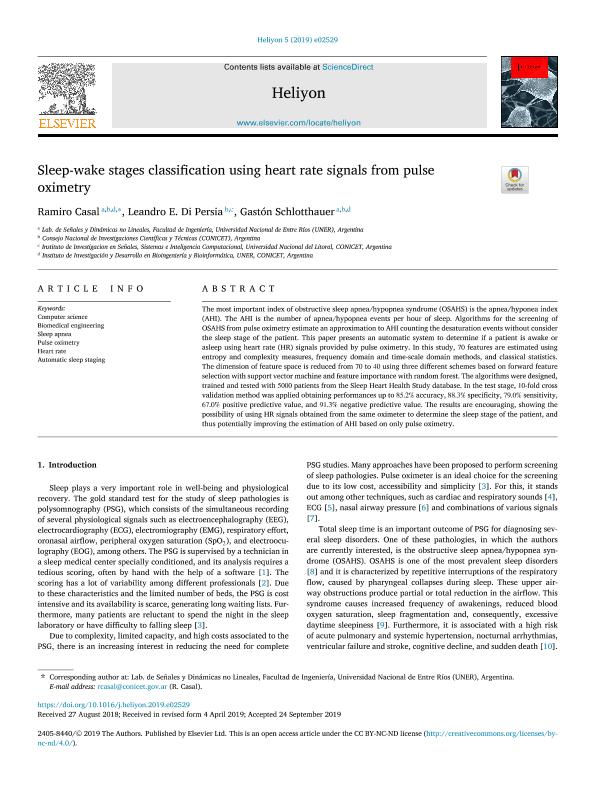Mostrar el registro sencillo del ítem
dc.contributor.author
Casal, Ramiro

dc.contributor.author
Di Persia, Leandro Ezequiel

dc.contributor.author
Schlotthauer, Gaston

dc.date.available
2020-06-03T14:07:44Z
dc.date.issued
2019-10
dc.identifier.citation
Casal, Ramiro; Di Persia, Leandro Ezequiel; Schlotthauer, Gaston; Sleep-wake stages classification using heart rate signals from pulse oximetry; Elsevier; Heliyon; 5; 10; 10-2019; e02529-1/12
dc.identifier.issn
2405-8440
dc.identifier.uri
http://hdl.handle.net/11336/106576
dc.description.abstract
The most important index of obstructive sleep apnea/hypopnea syndrome (OSAHS) is the apnea/hyponea index (AHI). The AHI is the number of apnea/hypopnea events per hour of sleep. Algorithms for the screening of OSAHS from pulse oximetry estimate an approximation to AHI counting the desaturation events without consider the sleep stage of the patient. This paper presents an automatic system to determine if a patient is awake or asleep using heart rate (HR) signals provided by pulse oximetry. In this study, 70 features are estimated using entropy and complexity measures, frequency domain and time-scale domain methods, and classical statistics. The dimension of feature space is reduced from 70 to 40 using three different schemes based on forward feature selection with support vector machine and feature importance with random forest. The algorithms were designed, trained and tested with 5000 patients from the Sleep Heart Health Study database. In the test stage, 10-fold cross validation method was applied obtaining performances up to 85.2% accuracy, 88.3% specificity, 79.0% sensitivity, 67.0% positive predictive value, and 91.3% negative predictive value. The results are encouraging, showing the possibility of using HR signals obtained from the same oximeter to determine the sleep stage of the patient, and thus potentially improving the estimation of AHI based on only pulse oximetry.
dc.format
application/pdf
dc.language.iso
eng
dc.publisher
Elsevier
dc.rights
info:eu-repo/semantics/openAccess
dc.rights.uri
https://creativecommons.org/licenses/by-nc-sa/2.5/ar/
dc.subject
SLEEP APNEA
dc.subject
PULSE OXIMETRY
dc.subject
HEART RATE
dc.subject
AUTOMATIC SLEEP STAGING
dc.subject.classification
Otras Ingeniería Eléctrica, Ingeniería Electrónica e Ingeniería de la Información

dc.subject.classification
Ingeniería Eléctrica, Ingeniería Electrónica e Ingeniería de la Información

dc.subject.classification
INGENIERÍAS Y TECNOLOGÍAS

dc.title
Sleep-wake stages classification using heart rate signals from pulse oximetry
dc.type
info:eu-repo/semantics/article
dc.type
info:ar-repo/semantics/artículo
dc.type
info:eu-repo/semantics/publishedVersion
dc.date.updated
2020-06-01T13:39:30Z
dc.journal.volume
5
dc.journal.number
10
dc.journal.pagination
e02529-1/12
dc.journal.pais
Países Bajos

dc.description.fil
Fil: Casal, Ramiro. Universidad Nacional de Entre Ríos. Instituto de Investigación y Desarrollo en Bioingeniería y Bioinformática - Consejo Nacional de Investigaciones Científicas y Técnicas. Centro Científico Tecnológico Conicet - Santa Fe. Instituto de Investigación y Desarrollo en Bioingeniería y Bioinformática; Argentina
dc.description.fil
Fil: Di Persia, Leandro Ezequiel. Universidad Nacional del Litoral. Facultad de Ingeniería y Ciencias Hídricas. Departamento de Informática. Laboratorio de Investigaciones en Señales e Inteligencia Computacional; Argentina
dc.description.fil
Fil: Schlotthauer, Gaston. Universidad Nacional de Entre Ríos. Instituto de Investigación y Desarrollo en Bioingeniería y Bioinformática - Consejo Nacional de Investigaciones Científicas y Técnicas. Centro Científico Tecnológico Conicet - Santa Fe. Instituto de Investigación y Desarrollo en Bioingeniería y Bioinformática; Argentina
dc.journal.title
Heliyon
dc.relation.alternativeid
info:eu-repo/semantics/altIdentifier/url/https://linkinghub.elsevier.com/retrieve/pii/S2405844019361894
dc.relation.alternativeid
info:eu-repo/semantics/altIdentifier/doi/http://dx.doi.org/10.1016/j.heliyon.2019.e02529
Archivos asociados
